Executive Summary
The background research undertaken provides that loyalty card schemes are amongst the most popular loyalty schemes with the customers where the customers are provided discounts and rewards for their repeat purchases with the company. Stores like HMV, Marks & Spencer and even Body Shop have variations of loyalty card-based programs for their customers. Based on the background research the problem that was identified was whether the people are aware of The Body Shop’s loyalty card and whether they find it worth buying it. Primary research was conducted through questionnaire-based surveys and in-depth interviews that highlighted that the respondents of the primary research were mostly customers of the body shop and had used its loyalty card. The research also provided that the loyalty card was one of the main factors for them making purchases at the Body Shop. They especially looked forward to the GBP 10 worth of birthday gifts and the 10% discount on their purchases at Body Shop. The research also provides recommendations that highlight how the Body Shop can increase customer loyalty by enhancing the rewards and privileges provided by its loyalty card.
Research Background Section
Loyalty-based marketing is aimed at targeting the current as well as new customers of the brand to extend their lifetime with the company and induce repeat purchase behavior. Companies strive to attain customers that are loyal to their brand as they are easier to cater to again while being less costly and are willing to pay higher premium-based prices for the products and services bought.
Retailers often provide their customers with a card-based loyalty scheme where the increased purchase of the cardholder results in increased discounts and rewards being earned by them. The Body Shop has also launched a loyalty-based card scheme that rewards its customers who make repeat purchases from the company for its various products. “The Love your body card scheme, based on an initiative run by the company in the U.S., replaces its current Earn and redeem the card. Rather than saving points on the card to be redeemed against later purchases, customers who pay £ 5 to join will receive an immediate 10% discount on all products, as well as free gifts, depending on the value of their purchases. The Body Shop claims the card has been a success in the U.S., where retail sales grew by 5% to £ 164.4m in the past year, compared with Great Britain’s 10% decline to £ 161.5m.” (‘The Body Shop in loyalty overhaul’, 2004).
Other retailers and brands that have launched similar reward card-based loyalty schemes include HMV music and stores. “HMV aims to urge customer loyalty with the launch of a pure HMV reward card. It offers consumers’ money-can’t- buy products and experiences. With this, customers will be able to redeem points, accrued on the card through purchases, for items such assigned products, back-stage passes and invitations to special events” (Fitzgerald, 2008). Pathmark Stores have the Pathmark Advantage Payment Card that enhances the “Pathmark Advantage Club loyalty card program in the U.S. Through the new card system, customers can easily do the one-swipe payment process that generates loyalty rewards. In addition, the company used its in-store television network as a primary marketing communication vehicle” (Duff, 2007). Marks & Spencers, House of Fraser as well as other luxury brands like Tommy Hilfiger, Victoria’s Secret all have their own versions of loyalty card schemes that they have launched to increase awareness of their brands as well as use discounts and rewards to induce repeat purchase amongst their customers.
In order to successfully build a card-based loyalty program and reap benefits from it, the companies should market the card along with the loyalty-based scheme to the customers through advertisements while building PR for the brand and the company. Additionally, they should strive for merchandising the card inside the stores as well as providing it through the associated business partners and brands that complement the product offering for the company. Distributing the loyalty card as a gift card is also useful as the current customers of the brand can increase the customer base of the company by word of mouth marketing and giving the gift loyalty cards to their families and peers. Aside from this loyalty cards and “stored-value cards provide speedy transaction time at the counter” (Fleenor, 2006). They “can enhance customer loyalty and endorse store merchandises and product offerings.” (Fleenor, 2006)
In recent years the concept of loyalty card-based schemes has somewhat come under threat as Barclays, HSBC and Egg have closed their loyalty card schemes. The main reason is customer dissatisfaction and the lack of performance of the schemes where they have become a gimmick instead of a loyalty marketing strategy. “Unless an organization can prove a program is delivering more than it’s costing, they should not be doing it” (Rubach, 2002). Taking this into perspective The Body Shop loyalty program is assessed by this research to determine how effective it is, whether it increases the loyalty of the customers to the brand while increasing the brand awareness in the market as well.
Research Objectives & Questions
The objective of the research is to determine how loyalty card-based marketing and customer loyalty programs affect the business. The proposed research undertaken aims to highlight the usage of the loyalty card by The Body Shop and whether it is well received in the market. The problem that is identified is whether the people are aware of The Body Shop’s loyalty card and whether they find it worth buying.
The research questions that have been formulated for this research pertaining to the following:
- Is the preferred loyalty card being used by the cardholders?
- How do loyalty cardholders evaluate the privileges associated with the card? Is it worth the discount or not?
- What are the perceived benefits and weaknesses of the loyalty card, and why?
- Is the loyalty card an important factor in coming to The Body Shop?
- How often and when do cardholders use their loyalty cards?
- What improvements should be made regarding the card or the extended privileges?
- What is the demographic profile of the people who have The Body shop loyalty card?
Research Components and Outcome
The research that is undertaken takes an explorative format where qualitative data is collected through primary as well as secondary sources to determine whether the card-based loyalty scheme is well received by the target market and what are their perceptions of the scheme. The research includes a background research-based literature review, market research that is undertaken using a questionnaire as well as in-depth interviews with correspondents with the target market for The Body Shop that reveal opinions and perceptions about the loyalty card scheme launched by The Body Shop. The main purpose of the research on The Body Shop is to collect information about the loyalty card, whether it is well known about and it is not being used as expected and why customers are not interested.
Research Design
The research undertaken comprises primary as well as secondary research. The secondary research makes use of peer-reviewed scholarly journal-based articles retrieved from journal databases as well as consumer magazines and marketing trade periodicals. The website of the Body Shop Company has also been reviewed for details on the loyalty card scheme provided by them to their customers.
For the primary research specific to their research we have targeted a segment of The Body Shop customers pertaining to female university students. The primary research is conducted through the use of a questionnaire-based survey as well as in-depth interviews conducted on respondents from the target market. The sample size that was taken from the population was that of 30 respondents; however, a sample of 250 respondents could have been taken to support full-scale research. The sampling methodology was used as a non-probability-based convenience sampling methodology for both the questionnaire-based survey as well as the in-depth interviews. The research administration was conducted through sell filling questionnaires that were distributed amongst the respondents while a researcher was available for any inquiries on part of the respondents. The interviews conducted were face-to-face interviews. The reason why the researcher was interactively involved with the respondents for the data collection was because of the easy availability of the respondents and the close proximity of the researcher to the respondents who were female university students themselves.
Questionnaires
The questionnaires that were used for the survey were made up of 12 close-ended questions that provided information pertaining to the demographics of the respondent, sample of their past purchases with Body Shop, the frequency of their purchases with, their perception of Body Shop and the loyalty card scheme at the company. The reason for the usage of the loyalty cards by the respondents as well as the frequency of the usage was tracked in the questionnaire. The previous questionnaire that was developed had all questions in the open-ended format. However as it was discovered that such a questionnaire would be difficult to analyze and determine trends form, the questions were changed into the closed question format with Likert and differential scales being used for the multiple choices provided. The pre and post-test questionnaires are provided in the appendix.
Exploratory Research Questions
The questions that were incorporated in the exploratory research technique of in-depth interviews were more open as compared to the questionnaire-based survey. These questions targeted the opinions of the respondents pertaining to the brand and image of the Body Shop and the associations that they link with the brand. The reason for the customer’s purchases from the shop was also queried along with the value that is perceived by the customers of the privileges and the discount opportunities that are provided to the holders of the loyalty program. Aside from this, the respondent was also queried on what changes could be made to the loyalty card programs to make them more worthy for the customers.
Data Analysis
The following depicts the analysis of the questionnaire-based survey for the research undertaken.
The majority of the respondents were aged between 18-25 years of age.
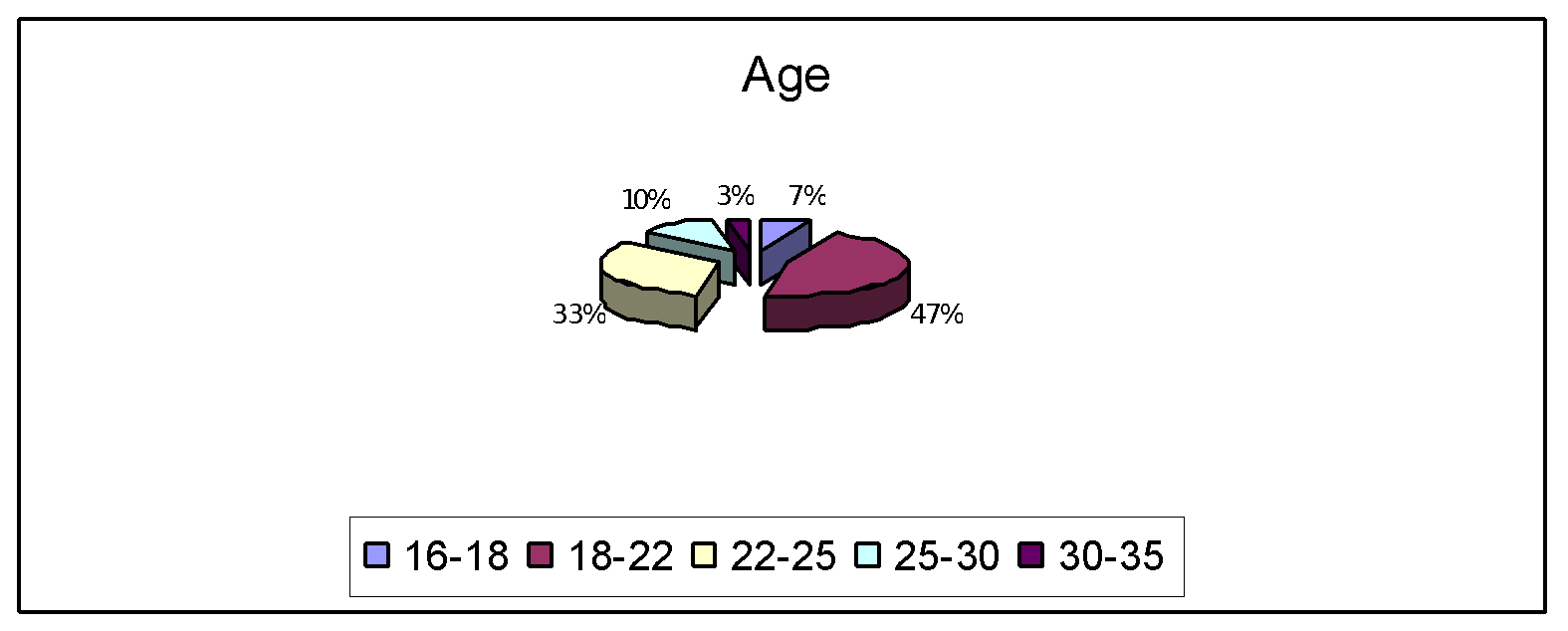
The ethnicity of the respondents was mainly British and African with a third majority of South Asian.
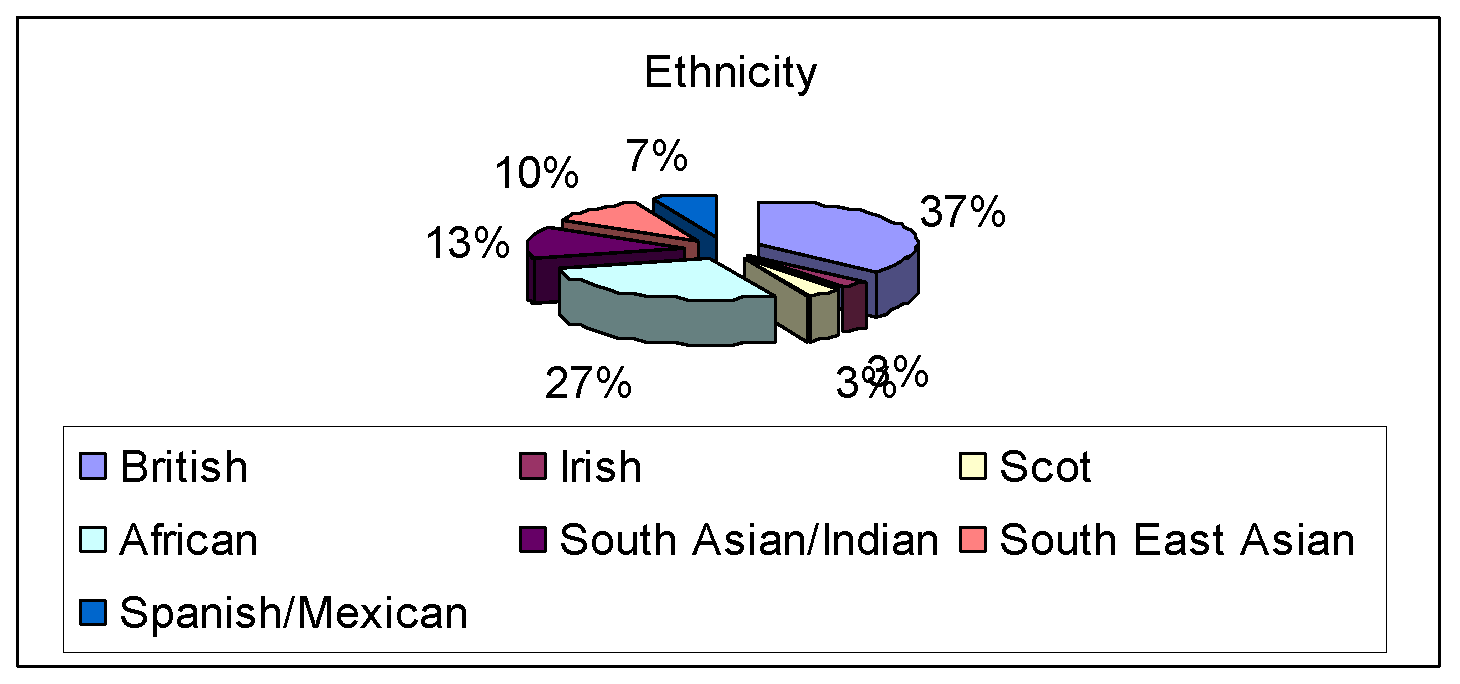
The skin type of the respondents was mainly oily with a second majority of normal
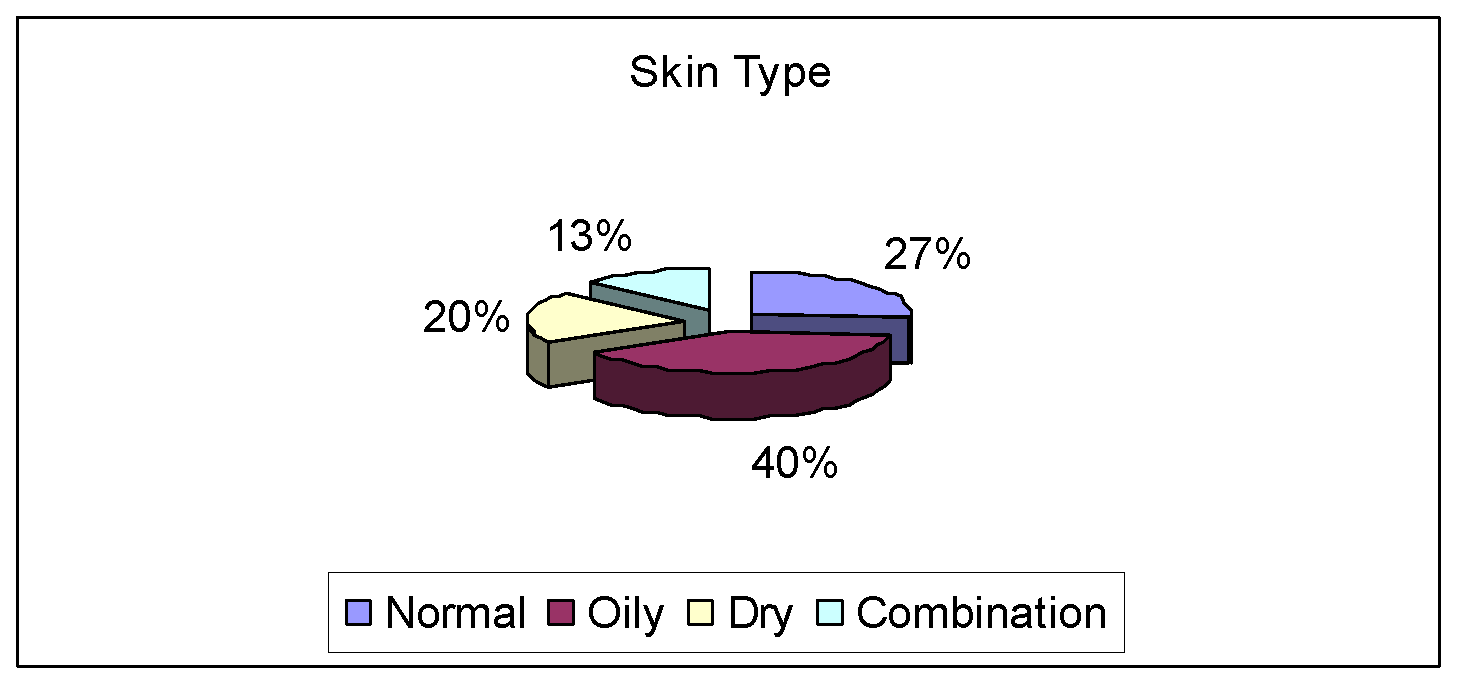
The fashion orientation of the respondents was mainly smart and casual.
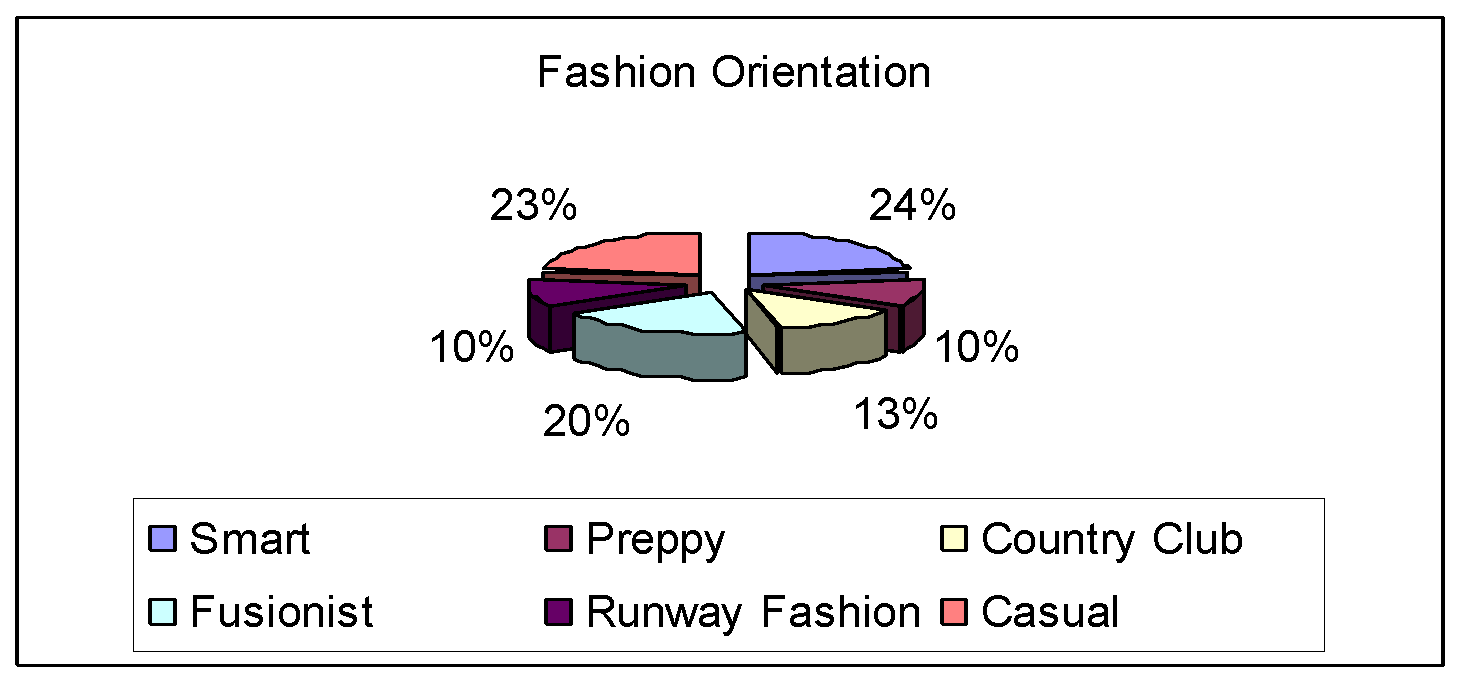
Ninety percent of the respondents were pro-animal rights.
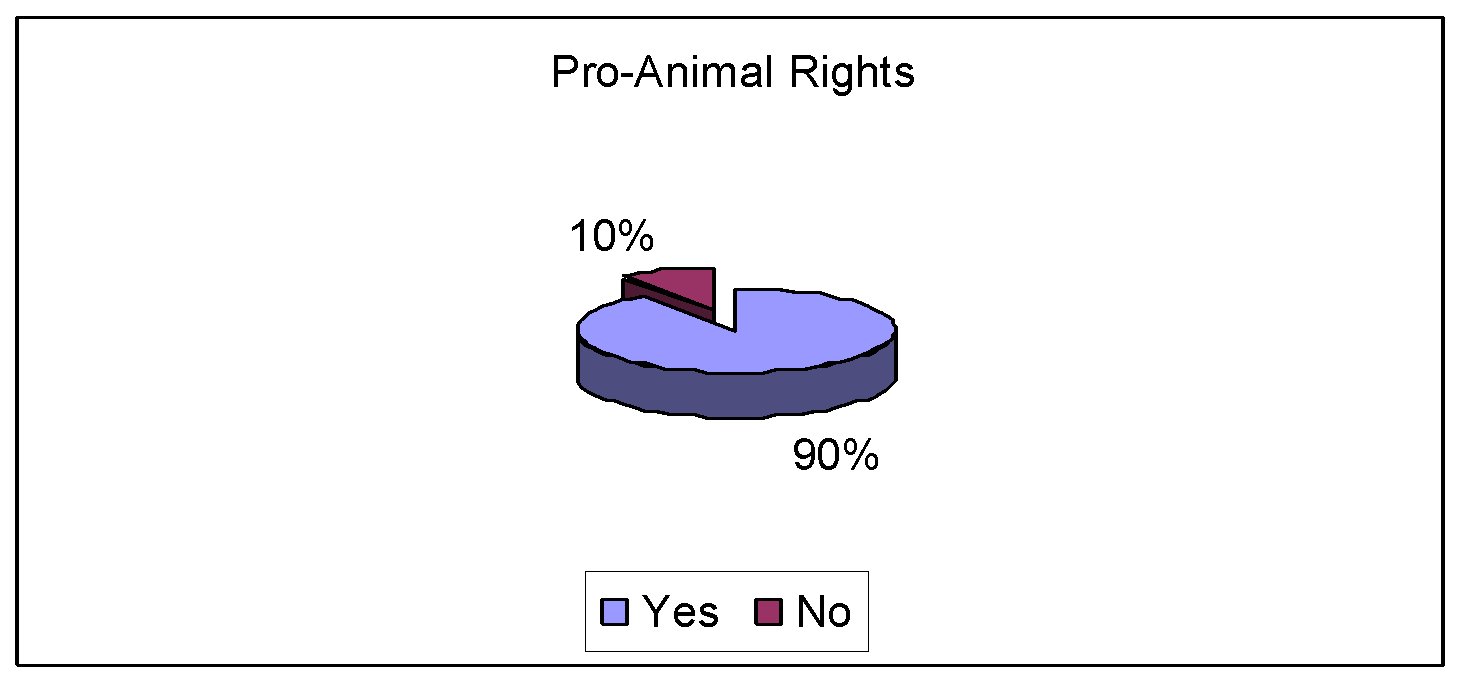
Sixty three percent of the respondents were pro-community based development
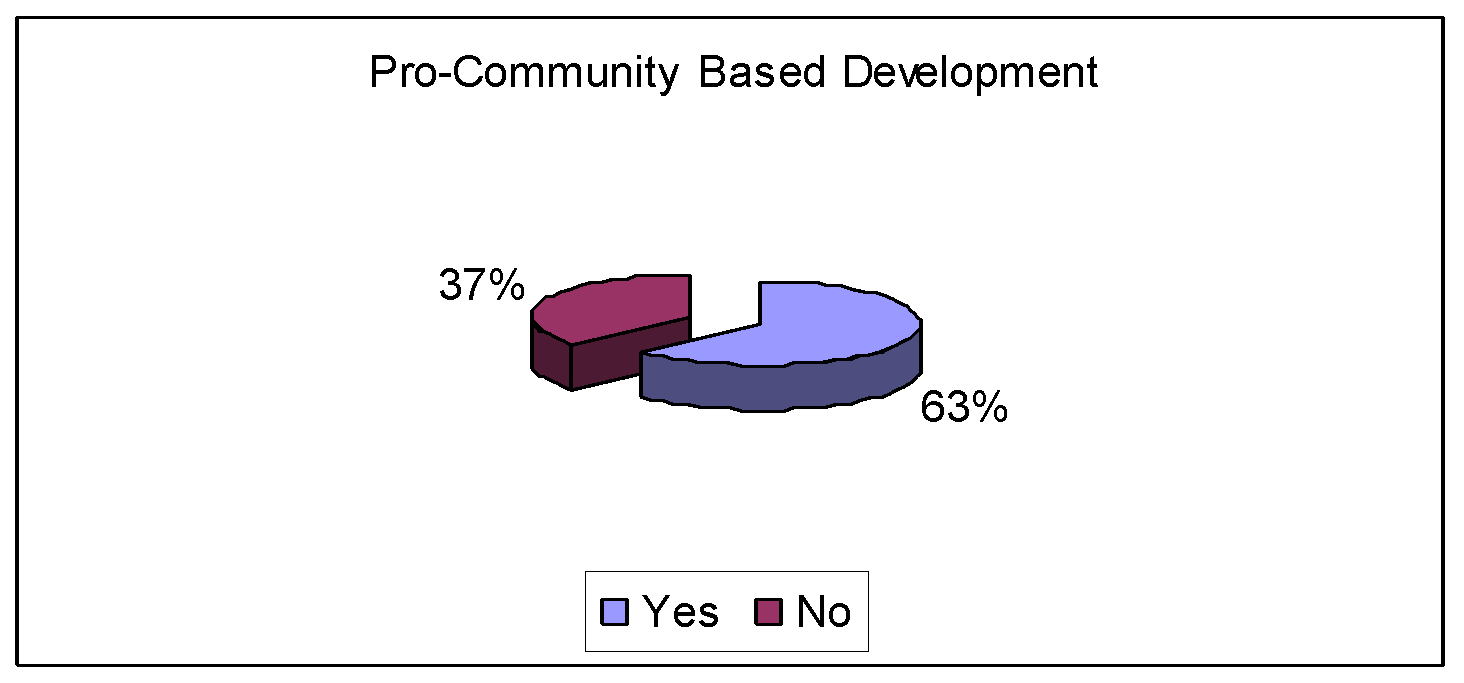
All of the respondents had made purchases from the Body Shop
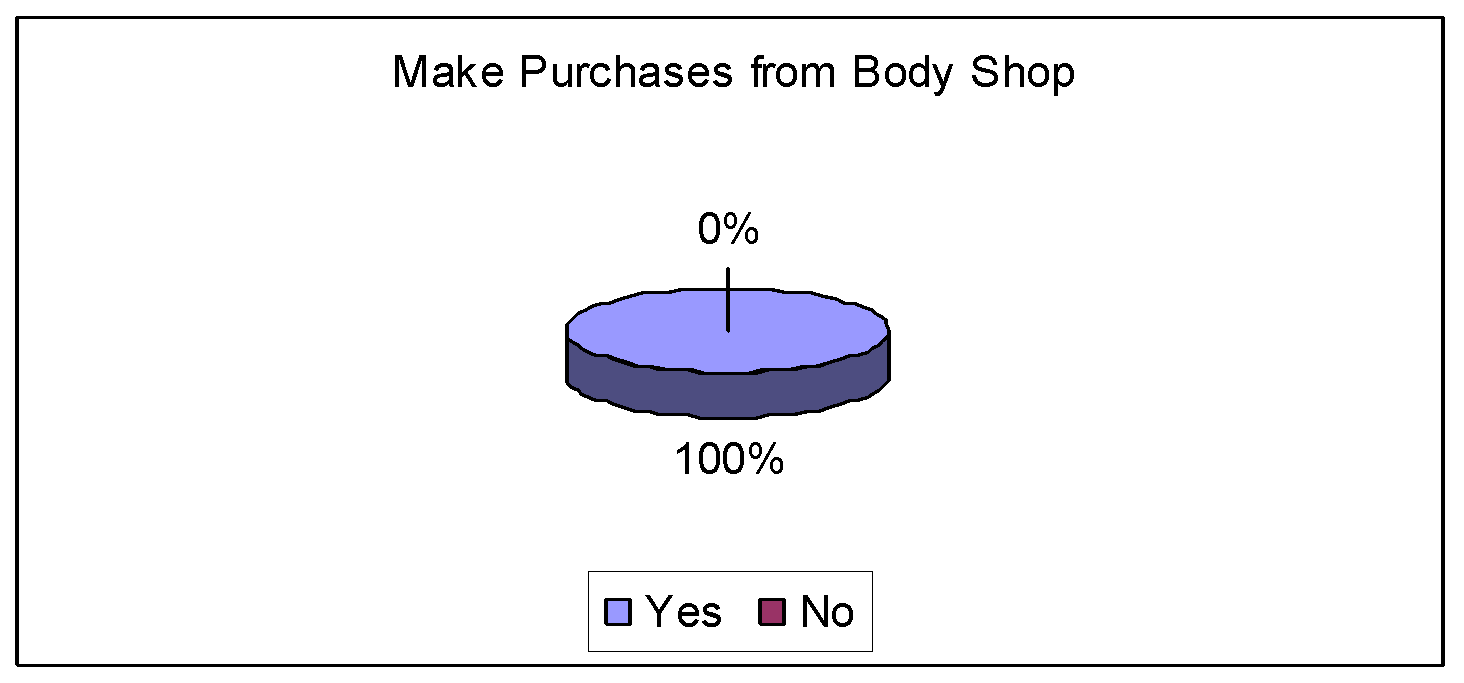
All of the respondents were aware of the Body Shop Loyalty card
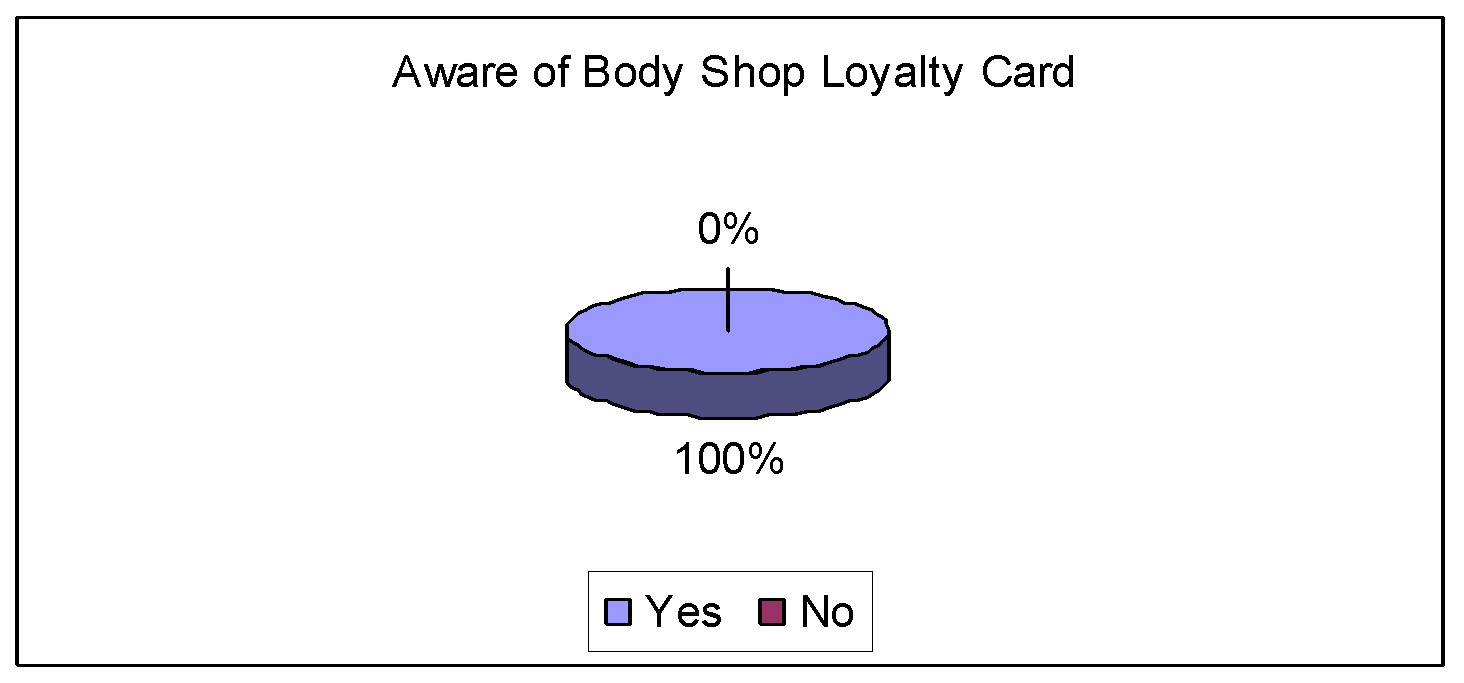
Ninety three percent of the respondents had used the Body Shop loyalty card.
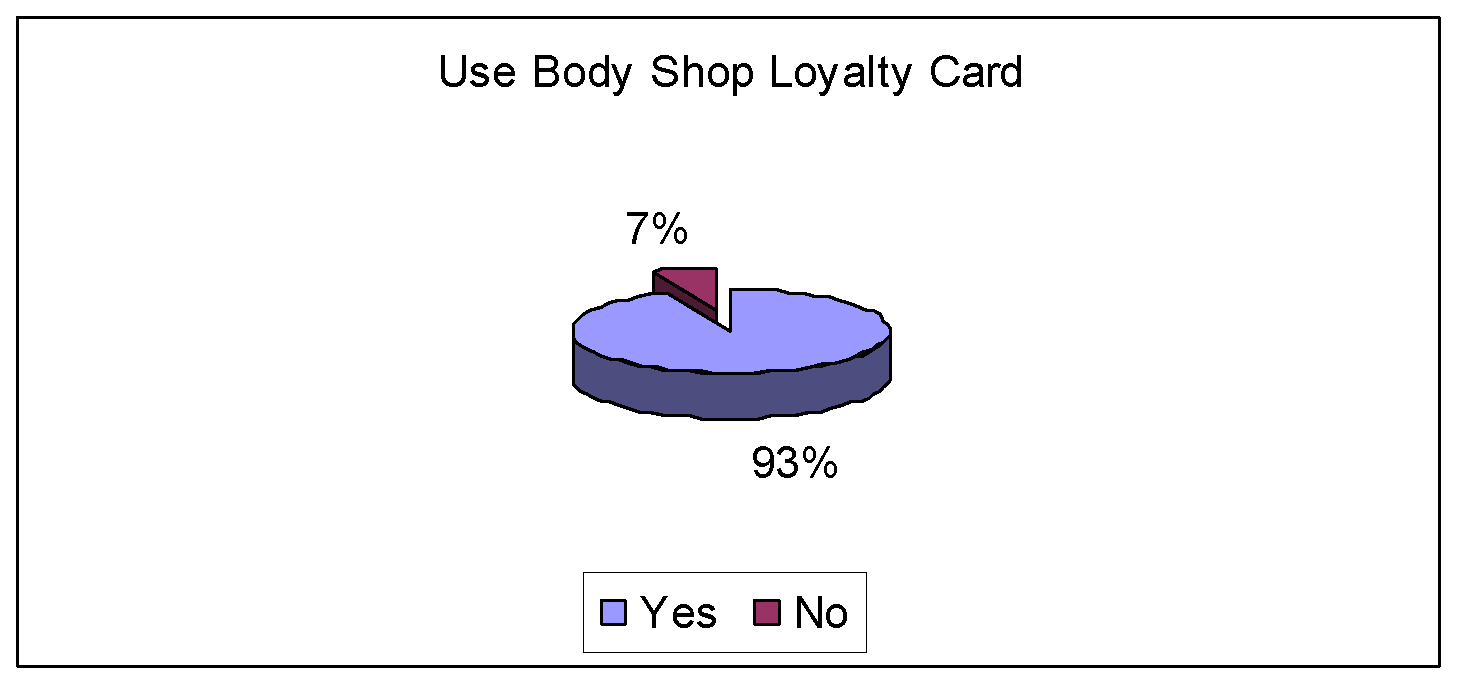
The following depicts the reasons for the respondents making purchases with the Body Shop loyalty card.
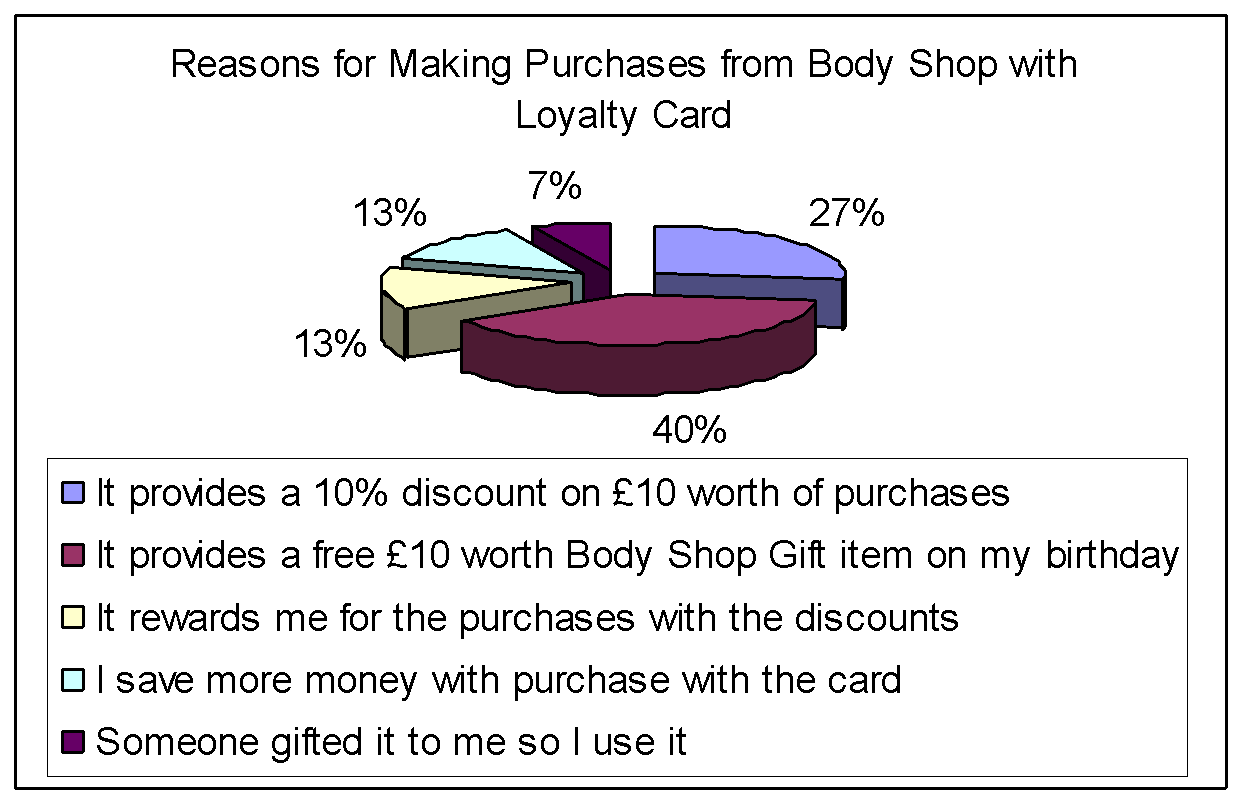
The following depicts the frequency of purchases made by the respondents with the Body Shop loyalty card.
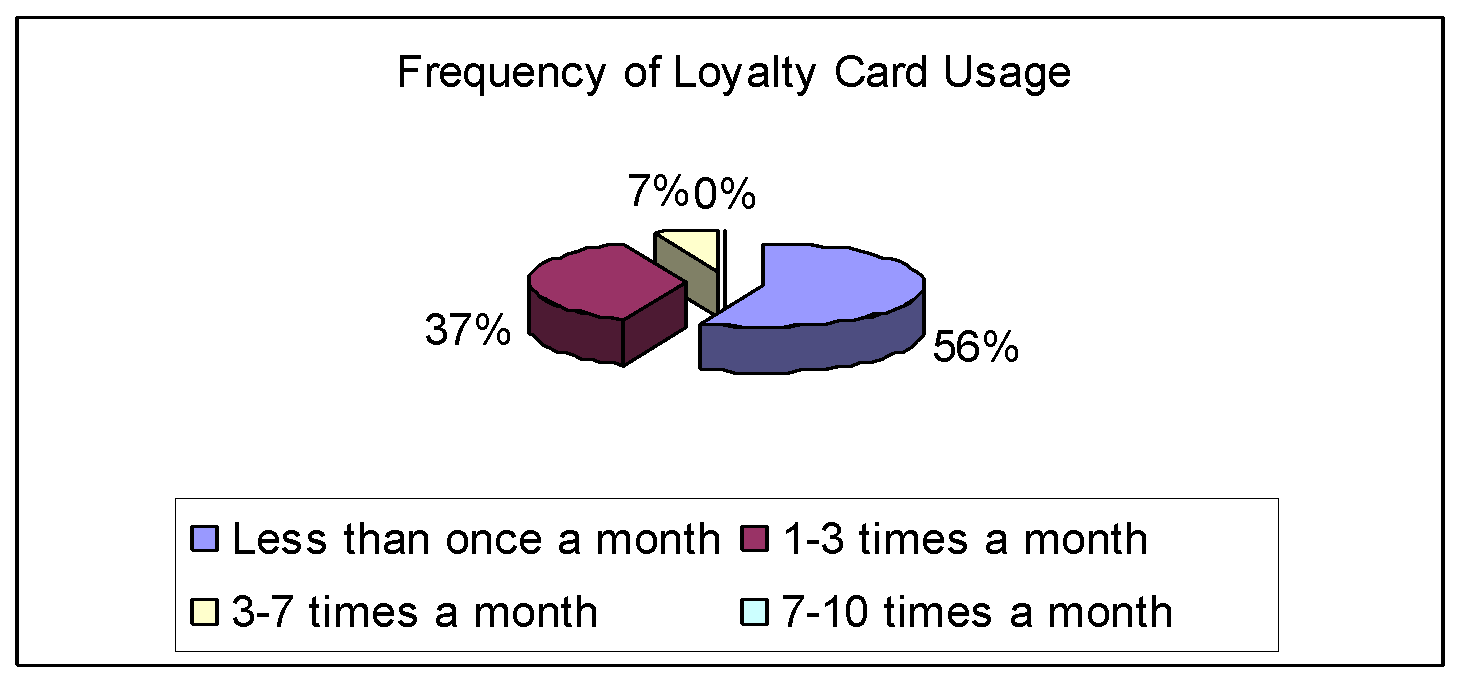
Majority of the respondents agreed with the loyalty card being a main factor in making purchases from the Body Shop.
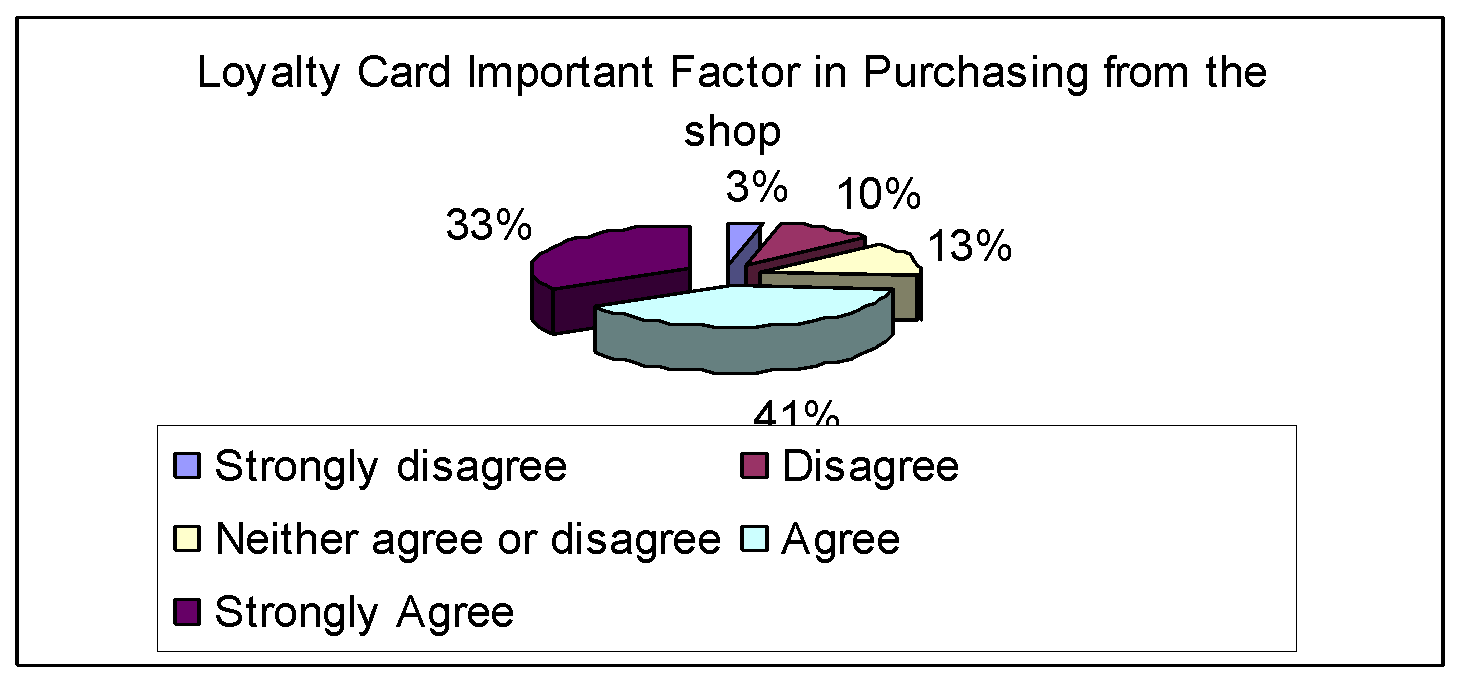
The following depicts the improvements that could be made to the Body Shop loyalty card scheme.
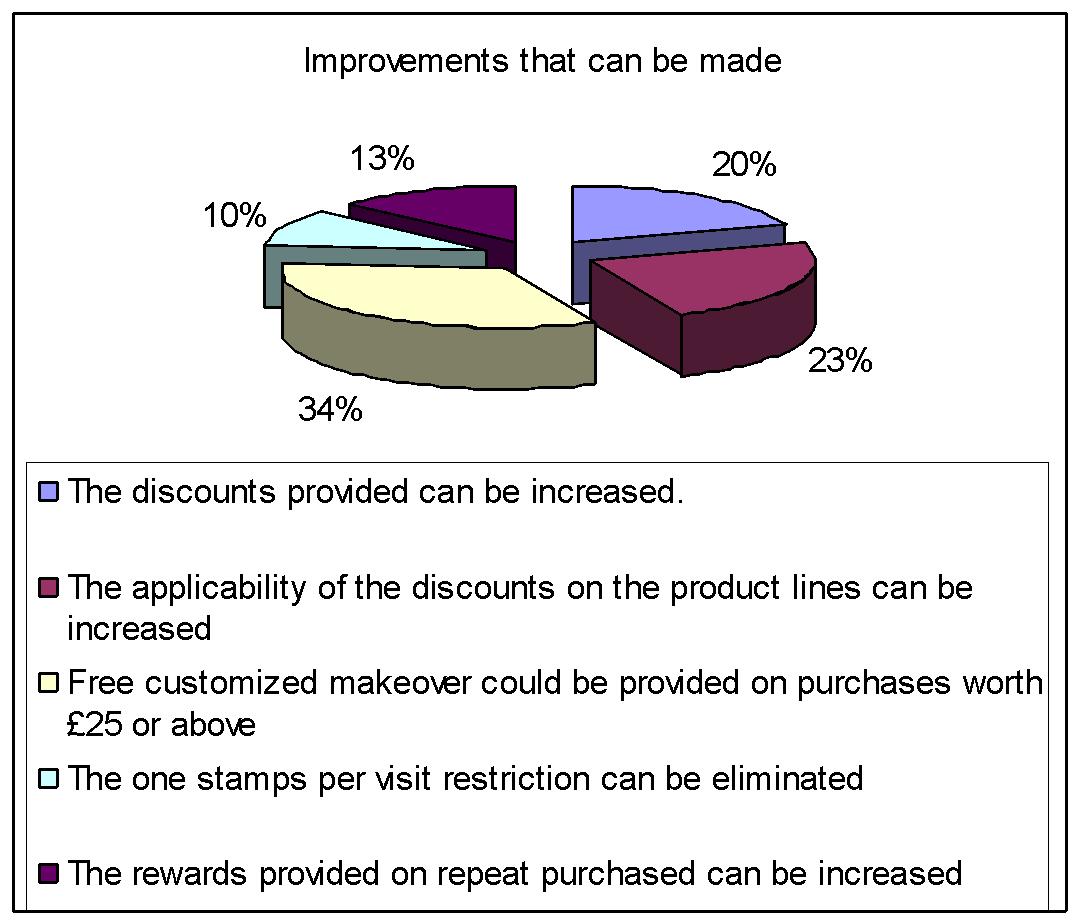
Findings and Recommendations
The research revealed that the demographic profile of the Body Shop customers was such that they are aged between 18 to 30 years with few being above 30 as well. Their ethnic orientation is mainly British and African with a third majority of South Asians and Indians. The majority of the respondents had either a normal or an oily skin type and were oriented towards smart casual and fusionist types of fashion. The research also revealed that the majority of the customers for the Body Shop were pro-animal rights and community-based development. All of the respondents had made purchases from the Body Shop and were aware of the Body Shop loyalty card. A great majority of the respondents at 93% had used the loyalty card. The research also depicted that the respondents tend to use the Body Shop loyalty card from 0-3 times a month. The reason that was highlighted by the respondents for making purchases at Body Shop using the loyalty card pertained to availing discounts, saving money on the card and receiving the GBP 10 birthday gift. 74 percent of the respondents surveyed provided that they agreed to the loyalty card being the main reason for them making purchases from the body shop.
Through the research, it was also highlighted that in order to make the loyalty card scheme work for the Body Shop in the long term, the company would have to invest in customer relations and loyalty schemes that highlight increased discounting on the card and applicability of the discount on more products provided by the company. Moreover the prospect of a free makeover by the Body Shop on a purchase of GBP 25 or above was also well received by the customers of the brand.
Limitations
The limitation of the study and the undertaken research mainly pertained to the target market selection and the use of the sampling technique. A convince-based sampling methodology was employed in a small niche market segment for the Body Shop specific to female university students. This small niche-based sample selection could lead to limited recognition of the trends and popularity of the Body Shop loyalty card and scheme. Additionally the research undertaken was specifically for Body Shop loyalty card schemes and cannot be generalized to other loyalty card schemes for other brands.
Bibliography and Referencing
- 2004, The Body Shop in loyalty overhaul, Marketing, p4-4, 1/9p, 1 color.
- Day, J., 1999, Body Shop rolls out loyalty card, Marketing Week, Vol. 22 Issue 33, p9, 1/3p, 1 color.
- Fitzgerald, M., 2008, HMV to roll out reward card, Marketing, p2-2, 1/4p.
- Duff, M., 2007,Loyalty debit card to star on Pathmark network, Retailing Today, Vol. 46 Issue 17, p15-19, 2p.
- Curtis, J., 1999, Cards versus cuts in the loyalty war, Marketing, p37, 2p, 1 chart, 11 color.
- Fleenor, D. G., 2006, Tips for a successful card program, National Petroleum News, Vol. 98 Issue 5, p42-42, 1/2p.
- Rubach, E., 2002, Loyalty cards vs. price cuts: which is more persuasive, Precision Marketing; 2/15/2002, Vol. 14 Issue 20, p2, 1/2p, 2 color.
